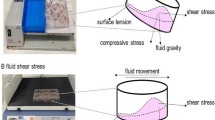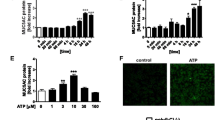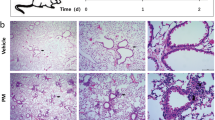Abstract
Exposure to airborne particulate matter (PM) is a worldwide health problem. Previous studies have reported that PMs induced depolarizing currents and increased intracellular Ca2+ in human bronchial epithelial cells. Ca2+ plays important role in the regulation of mucus exocytosis, and mucin hypersecretion is a key pathological feature of inflammatory respiratory diseases. To explore more mechanisms underlying PM toxicity, we measured PM-induced mucin secretion in human bronchial epithelial (16HBE) cells. MUC5AC secretion and cyclic adenosine monophosphate (cAMP) level were detected by ELISA. Transient receptor potential vanilloid (TRPV)1 inward currents were examined by electrophysiology. Ca2+ concentration was assessed by laser scanning confocal microscope. Exposure of PMs to 16HBE cells was found to induce mucin secretion, as a consequence of sustained Ca2+ influx and cAMP increase through TRPV1 receptors. Mucin secretion was completely inhibited by TRPV1 receptor antagonist capsazepine. Removal of Ca2+ by Ca2+ chelator BAPTA or inhibition of protein kinase A (PKA) by the PKA inhibitors H-89 each partially reduced PC2s-induced mucin secretion. The combination of BAPTA and H-89 completely prevented mucin secretion mediated by PMs. These results suggest that PM induces mucin secretion through Ca2+ influx and cAMP/PKA pathway by TRPV1 receptors in human bronchial epithelial cells, thereby providing a potential mechanism to reduce PM toxicity.





Similar content being viewed by others
References
Rogers, D.F. 2007. Physiology of airway mucus secretion and pathophysiology of hypersecretion. Respir Care 52(9): 1134–1146.
Del Donno, M., D. Bittesnich, A. Chetta, D. Olivieri, and M.T. Lopez-Vidriero. 2000. The effect of inflammation on mucociliary clearance in asthma: an overview. Chest 118(4): 1142–1149.
Houtmeyers, E., R. Gosselink, G. Gayan-Ramirez, and M. Decramer. 1999. Regulation of mucociliary clearance in health and disease. Eur Respir J 13(5): 1177–1188.
Maestrelli, P., M. Saetta, C.E. Mapp, and L.M. Fabbri. 2001. Remodeling in response to infection and injury. Airway inflammation and hypersecretion of mucus in smoking subjects with chronic obstructive pulmonary disease. Am J Respir Crit Care Med 164(10 Pt 2): S76–S80.
Robinson, M., and P.T. Bye. 2002. Mucociliary clearance in cystic fibrosis. Pediatr Pulmonol 33(4): 293–306.
Rogers, D.F., and P.J. Barnes. 2006. Treatment of airway mucus hypersecretion. Ann Med 38(2): 116–125.
Adler, K.B., and Y. Li. 2001. Airway epithelium and mucus: intracellular signaling pathways for gene expression and secretion. Am J Respir Cell Mol Biol 25(4): 397–400.
Davis, C.W., and E. Lazarowski. 2008. Coupling of airway ciliary activity and mucin secretion to mechanical stresses by purinergic signaling. Respir Physiol Neurobiol 163(1–3): 208–213.
Kemp, P.A., R.A. Sugar, and A.D. Jackson. 2004. Nucleotide-mediated mucin secretion from differentiated human bronchial epithelial cells. Am J Respir Cell Mol Biol 31(4): 446–455.
Dockery, D.W., and C.A. Pope 3rd. 1994. Acute respiratory effects of particulate air pollution. Annu Rev Public Health 15: 107–132.
Ostro, B., R. Broadwin, and M.J. Lipsett. 2000. Coarse and fine particles and daily mortality in the Coachella Valley, California: a follow-up study. J Expo Anal Environ Epidemiol 10: 412–419.
Løvik, M., A.K. Høgseth, P.I. Gaarder, R. Hagemann, and I. Eide. 1997. Diesel exhaust particles and carbon black have adjuvant activity on the local lymph node response and systemic IgE production to ovalbumin. Toxicology 121: 165–178.
Imrich, A., Y.Y. Ning, and L. Kobzik. 2000. Insoluble components of concentrated air particles mediate alveolar macrophage responses in vitro. Toxicol Appl Pharmacol 167: 140–150.
Peters, A., H.E. Weichmann, T. Tuch, J. Heinrich, and J. Heyder. 1997. Respiratory effects are associated with the number of ultrafine particles. Am J Respir Crit Care Med 155: 1376–1383.
Sunyer, J., and X. Basagaña. 2001. Particles, and not gases, are associated with the risk of death in patients with chronic obstructive pulmonary disease. Int J Epidemiol 30(5): 1138–1140.
Saunders, V., P. Breysse, J. Clark, A. Sproles, M. Davila, and M. Wills-Karp. 2010. Particulate matter-induced airway hyperresponsiveness is lymphocyte dependent. Environ Health Perspect 118(5): 640–646.
Caterina, M.J., M.A. Schumacher, M. Tominaga, T.A. Rosen, J.D. Levine, and D. Julius. 1997. The capsaicin receptor: a heat-activated ion channel in the pain pathway. Nature 389(6653): 816–824.
Veronesi, B., M. Oortgiesen, J.D. Carter, and R.B. Devlin. 1998. Particulate matter initiates inflammatory cytokine release by activation of capsaicin and acid receptors in a human bronchial epithelial cell line. Toxicol Appl Pharmacol 154(1): 106–115.
Veronesi, B., M. Oortgiesen, J. Roy, J.D. Carter, S.A. Simon, and S.H. Gavett. 2000. Vanilloid (capsaicin) receptors influence inflammatory sensitivity in response to particulate matter. Toxicol Appl Pharmacol 169(1): 66–76.
Choi, J.Y., J.H. Shin, J.L. Kim, S.H. Jung, E.J. Son, M.H. Song, S.H. Kim, and J.H. Yoon. 2005. P2Y2 agonist induces mucin secretion via Ca2+- and inositol 1,4,5-triphosphate-dependent pathway in human middle ear epithelial cells. Hear Res 209(1–2): 24–31.
Hoshino, M., S. Morita, H. Iwashita, Y. Sagiya, T. Nagi, A. Nakanishi, Y. Ashida, O. Nishimura, Y. Fujisawa, and M. Fujino. 2002. Increased expression of the human Ca2+-activated Cl- channel 1 (CaCC1) gene in the asthmatic airway. Am J Respir Crit Care Med 165(8): 1132–1136.
Agopyan, N., L. Li, S. Yu, and S.A. Simon. 2003. Negatively charged 2- and 10-microm particles activate vanilloid receptors, increase cAMP, and induce cytokine release. Toxicol Appl Pharmacol 186(2): 63–76.
Veronesi, B., C. de Haar, J. Roy, and M. Oortgiesen. 2002. Particulate matter inflammation and receptor sensitivity are target cell specific. Inhal Toxicol 14(2): 159–183.
Hamoir, J., A. Nemmar, D. Halloy, D. Wirth, G. Vincke, A. Vanderplasschen, B. Nemery, and P. Gustin. 2003. Effect of polystyrene particles on lung microvascular permeability in isolated perfused rabbit lungs: role of size and surface properties. Toxicol Appl Pharmacol 190: 278–285.
Veronesi, B., C. de Haar, L. Lee, and M. Oortgiesen. 2002. The surface charge of visible particulate matter predicts biological activation in human bronchial epithelial cells. Toxicol Appl Pharmacol 178: 144–154.
Oortgiesen, M., B. Veronesi, G. Eichenbaum, P.F. Kiser, and S.A. Simon. 2001. Residual oil fly ash and charged polymers activate epithelial cells and nociceptive sensory neurons. Am J Physiol Lung Cell Mol Physio l278: L683–L695.
Gray, T., P. Nettesheim, C. Loftin, J.S. Koo, J. Bonner, S. Peddada, and R. Langenbach. 2004. Interleukin-1beta-induced mucin production in human airway epithelium is mediated by cyclooxygenase-2, prostaglandin E2 receptors, and cyclic AMP-protein kinase A signaling. Mol Pharmacol 66(2): 337–346.
Voynow, J.A., L.R. Young, Y. Wang, T. Horger, M.C. Rose, and B.M. Fischer. 1999. Neutrophil elastase increases MUC5AC mRNA and protein expression in respiratory epithelial cells. Am J Physiol 276(5 Pt 1): L835–L843.
Agopyan, N., T. Bhatti, S. Yu, and S.A. Simon. 2003. Vanilloid receptor activation by 2- and 10-microm particles induces responses leading to apoptosis in human airway epithelial cells. Toxicol Appl Pharmacol 192(1): 21–35.
Kuyper, L.M., P.D. Paré, J.C. Hogg, R.K. Lambert, D. Ionescu, R. Woods, and T.R. Bai. 2003. Characterization of airway plugging in fatal asthma. Am J Med 115: 6–11.
Williams, O.W., A. Sharafkhaneh, V. Kim, B.F. Dickey, and C.M. Evans. 2006. Airway mucus: from production to secretion. Am J Respir Cell Mol Biol 34(5): 527–536.
Clapham, D.E. 2003. TRP channels as cellular sensors. Nature 426: 517–524.
Reilly, C.A., J.L. Taylor, D.L. Lanza, B.A. Carr, D.J. Crouch, and G.S. Yost. 2003. Capsaicinoids cause inflammation and epithelial cell death through activation of vanilloid receptors. Toxicol Sci 73(1): 170–181.
McCreanor, J., P. Cullinan, M.J. Nieuwenhuijsen, J. Stewart-Evans, E. Malliarou, L. Jarup, R. Harrington, M. Svartengren, I.-K. Han, P. Ohman-Strickland, K.F. Chung, and J. Zhang. 2007. Respiratory effects of exposure to diesel traffic in persons with asthma. N Engl J Med 357: 2348–2358.
Gilmour, M.I., M.S. Jaakkola, S.J. London, A.E. Nel, and C.A. Rogers. 2006. How exposure to environmental tobacco smoke, outdoor air pollutants, and increased pollen burdens infl uences the incidence of asthma. Environ Health Perspect 114: 627–633.
Oortgiesen, M., B. Veronesi, G. Eichenbaum, P.F. Kiser, and S.A. Simon. 2000. Residual oil fly ash and charged polymers activate epithelial cells and nociceptive sensory neurons. Am J Physiol Lung Cell Mol Physiol 278(4): L683–L695.
Haswell, L.E., K. Hewitt, D. Thorne, A. Richter, and M.D. Gaça. 2010. Cigarette smoke total particulate matter increases mucous secreting cell numbers in vitro: a potential model of goblet cell hyperplasia. Toxicol In Vitro 24(3): 981–987.
Mouadeb, D.A., P.C. Belafsky, M. Birchall, C. Hood, T. Konia, and K.E. Pinkerton. 2009. The effects of allergens and tobacco smoke on the laryngeal mucosa of guinea pigs. Otolaryngol Head Neck Surg 140(4): 493–497.
Jackson, A.D. 2001. Airway goblet-cell mucus secretion. Trends Pharmacol Sci 22(1): 39–45.
Kichko, T.I., and P.W. Reeh. 2009. TRPV1 controls acid- and heat-induced calcitonin gene-related peptide release and sensitization by bradykinin in the isolated mouse trachea. Eur J Neurosci 29(9): 1896–1904.
Hu, Y., Q. Gu, R.L. Lin, R. Kryscio, and L.Y. Lee. 2010. Calcium transient evoked by TRPV1 activators is enhanced by tumor necrosis factor-{alpha} in rat pulmonary sensory neurons. Am J Physiol Lung Cell Mol Physiol 299(4): L483–L492.
Gu, Q., and L.Y. Lee. 2010. Regulation of acid signaling in rat pulmonary sensory neurons by protease-activated receptor-2. Am J Physiol Lung Cell Mol Physiol 298(3): L454–L461.
Evans, C.M., K. Kim, M.J. Tuvim, and B.F. Dickey. 2009. Mucus hypersecretion in asthma: causes and effects. Curr Opin Pulm Med 15(1): 4–11.
Davis, C.W., and B.F. Dickey. 2008. Regulated airway goblet cell mucin secretion. Annu Rev Physiol. Annu Rev Physiol 70: 487–512.
Tuvim, M.J., A.R. Mospan, K.A. Burns, M. Chua, P.J. Mohler, E. Melicoff, R. Adachi, Z. Ammar-Aouchiche, C.W. Davis, and B.F. Dickey. 2009. Synaptotagmin 2 couples mucin granule exocytosis to Ca2+ signaling from endoplasmic reticulum. J Biol Chem 284(15): 9781–9787.
Bradbury, N.A. 2000. Protein kinase-A-mediated secretion of mucin from human colonic epithelial cells. J Cell Physiol 185(3): 408–415.
Hille, B., J. Billiard, D.F. Babcock, T. Nguyen, and D.S. Koh. 1999. Stimulation of exocytosis without a calcium signal. J Physiol 520: 23–31.
Foster, L.J., B. Yeung, M. Mohtashami, K. Ross, W.S. Trimble, and A. Klip. 1998. Binary interactions of the SNARE proteins syntaxin-4, SNAP23, and VAMP-2 and their regulation by phosphorylation. Biochemistry 37(31): 11089–11096.
Agopyan, N., J. Head, S. Yu, and S.A. Simon. 2004. TRPV1 receptors mediate particulate matter-induced apoptosis. Am J Physiol Lung Cell Mol Physiol 286(3): L563–L572.
Jung, S.R., M.H. Kim, B. Hille, T.D. Nguyen, and D.S. Koh. 2004. Regulation of exocytosis by purinergic receptors in pancreatic duct epithelial cells. Am J Physiol Cell Physiol 286(3): C573–C579.
Acknowledgments
This work was supported by grant from the National Nature Science Foundation of China (no. 31171346), and China–Russia Cooperation Research Foundation (NSFC 31211120168).
Author information
Authors and Affiliations
Corresponding author
Rights and permissions
About this article
Cite this article
Yu, H., Li, Q., Kolosov, V.P. et al. Regulation of Particulate Matter-Induced Mucin Secretion by Transient Receptor Potential Vanilloid 1 Receptors. Inflammation 35, 1851–1859 (2012). https://doi.org/10.1007/s10753-012-9506-x
Published:
Issue Date:
DOI: https://doi.org/10.1007/s10753-012-9506-x




